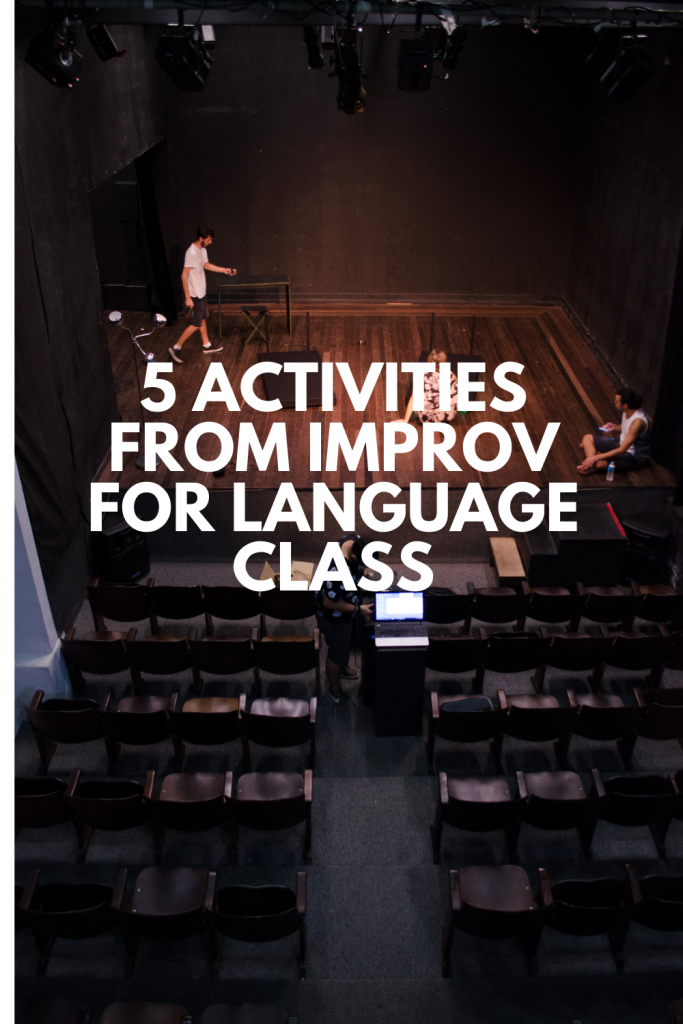
I absolutely love to use drama in my classroom. Drama is a huge passion of mine. I have one of my BA in Theatre Arts and have worked as an actress. Throughout my career teaching languages, I absolutely love to incorporate so many things that I have done and do as an actress and a writer into our work. It makes it more fun, it brings it to life, and gets everyone talking and communicating.
I wanted to share with you today five activities to practice meeting and greeting in other languages.
Alliteration. I’m not exactly sure what this would look like in Mandarin, for example, though I’m sure there’s an equivalent. This would be a much more advanced activity than it would be in Spanish or in French. Basically, whatever your name is (whether that’s your name or the name in the target language) you have to introduce yourself with an adjective of the same letter, of course. For example, Louisa Loca (Crazy Louisa). And then what everyone has to do that. You could incorporate ‘Me llamo Louisa Loca, y tú?’, (‘My name is Crazy Louisa, and what’s your name?)’. And then another student is going to do the same thing, and they are going to introduce themselves. At the beginning level, you could even have everyone repeat it. The second person repeats what the first person said and then what the second person said. If I’m the third person, i repeat the third person.
Making it a little bit more complicated, you could introduce yourself by getting that language (i.e. a greeting), ‘Hola, yo me llamo Luisa Loca, y tú, ¿comó te llamas?’, ‘Yo me llamo Barbara Bonita’, ‘Eres Luisa Loca’. You’re constantly going to build on that, and then you can introduce that person to another person. ‘Eres Luisa Loca’, ‘Te presento a Luisa Loca’. You get the picture. You can make this as complicated or as easy as you want. Just think about the language you want in there and what you want them to be able to repeat. If you’re doing basic adjectives, you might just do the alliteration with the adjectives, again making sure they agree in gender. If you want to add ‘My name is….’ go ahead and include that. If you want to add ‘What’s your name’, include that. If you want to bring that up to people introducing people to each other, recycle that into there. It’s lots of talking and it’s fun. You might want to start with just having everybody repeat everyone’s names, making sure they can do that, and then bring it up into introducing people to each other and getting all that ‘My name is…’ and ‘What’s your name?’ in there.
Greetings to people from all walks of life.This next one is really fun because you can do this with your upper levels and some of your lower level (towards end of year one or it’s an icebreaker in year 2). Basically, you give them a bunch of situations. Just write them down on a piece of paper. You could also write them down on the board and have them randomly change, or at your signal. For example, they have to greet the teacher. That uses formal language. Have them greet a famous person. Have them greet a famous artist from the target language culture. Have them greet a famous person from history. Have them greet a political leader from the target culture. Have them greet an actor. Have them greet a journalist. Have them greet different professions. What would they do? Have them greet using different emotions. Have them greet as if they’re happy, have them greet as if they’re sad, have them greet as if they’re scared, have them greet as if they’re excited. There is absolutely no limit to this. It’s a great way to recycle all kinds of vocabulary and not forget that beginning level stuff either.
Fingers. It’s a lot of fun. I would say this is really appropriate for the end of year 1, year 2. You know your students. This can even be done in upper levels.
You have everyone come together in a circle, and they put up their fingers. You can choose 5, 3, 10- whatever. Each student will have prepared a certain number of questions that can be answered with yes or no. People want to put their fingers down as they’re being eliminated. For example, do you live in a giant house? No, so I put my finger down. Were you born outside of the United States? No. Were you born in a hospital- anything that can be answered yes or no. It’s very communicative. It’s a great way to recycle any type of introductory personal information.
Name Ball. This is really basic and really fun. Again, all you’re doing is meeting and greeting, but you’re adding a ball to it. I introduce myself, I throw a ball to you, you introduce yourself to somebody else, and we just keep passing around this ball. Then, we’re going to pass around the ball and introduce other people to other people. Great way to get started with introductions and greetings and get some movement in your class.
The ‘My name is’ Circle. Have everybody in a big circle. The first person says, ‘Hello, my name is…’ (whatever that may be). And they’re going to be looking directly at somebody who is in the circle, and as they say that, they’re going to walk over and take that person’s space. As they’re moving into that space, that other person has to vacate immediately by making eye contact with another person and saying, ‘My name is….’ and then they’re going to go take that person’s space, and then the next person is going to move around and go to the other space until everybody is talking, talking, talking, and everyone has said what their name is.
Looking for more ways to make language class fun?
https://reallifelanguage.lpages.co/20-fun-activities-to-learn-a-language/